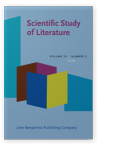Vol. 10:2 (2020) ► pp.228–249
The role of linguistic prosody in the responses to recited poetry
Psychological studies of poetry have focused on the responses to written text, and little is known on how choices made by reciters affect listeners’ responses. We hypothesized that syntax-compatible prosodic cues – pauses and pitch breaks – would increase preference by increasing comprehension. Participants rated different declamations of the same poem for preference and comprehension. The match between syntactic boundaries and linguistic prosody cues was quantified in each version, and then we tested how this match predicted listeners’ responses. Unlike our predictions, linguistic prosody had opposite effects on comprehension vs. preference: Comprehension was enhanced by using both sentence pauses and clause pitch breaks, while avoiding clause pauses. When controlling for comprehension, preference was enhanced by clause pauses but hampered by clause breaks and sentence pauses. Results are consistent with the possibility that listeners enjoyed losing track of syntactic boundaries, in line with the idea that deviation may lead to pleasure.
Article outline
- Method
- Participants
- Stimuli
- Procedure
- Statistical analysis
- Results
- 1.Effects of linguistic prosody on comprehension
- 2.Effects of linguistic prosody on preference
- 3.Effects of linguistic prosody and comprehension on preference
- 4.Effect of general acoustic cues on preference
- Discussion
- Supplementary materials
- Data availability statement
-
References
